Atalanta B.C. are widely known in Italy and increasingly in countries around the world for their very fluid attacking brand of football. Gian Gasperini has brought in a very unique style and structure to the side, and the club have been very astute with their business in the transfer market bringing in players to fit in. The attacking trio of Duván Zapata, Josip Iličić, and Alejandro Gómez is often the talking point in the Italian side, as they are key to the attacking success of the club, who scored the most goals in Serie A in the 2018/19 campaign and is on track to repeat this feat with 57 goals scored already this season.
An important part of the side that is often overlooked is the initial build-up structure that allows the three main attackers the freedom to find the success they do. One player that is essential to Gasperini’s set-up in a deeper role is Marten de Roon. The midfielder initially joined the side in the summer of 2015, but after only one season made the move to Middlesbrough. After a single season in England that ended in relegation, de Roon re-joined Atalanta, where he has since thrived.
In this tactical analysis scout report, we will take a look at de Roon’s role in Gasperini’s attacking machine. The tactics used by the Italian side have gotten the best out of the Dutch midfielder, and we will see how he is used on the attacking and defending side of the club’s game. In addition, this analysis will explore why de Roon could be a major contributor in the Netherlands Euro 2020 campaign as they look to establish themselves as a major force in Europe once again.
Atalanta structure
Before we get into de Roon’s specific position and role in the side, it is important to have a good grasp of Atalanta’s entire structure. Gasperini sets his side up in a very unique way that requires very specific players to get the best out of the system. The usual structure you will see the Italian outfit is a 3-4-1-2 or 3-4-2-1. Below you are able to see this typical set-up, as well as the normal movements of each player.
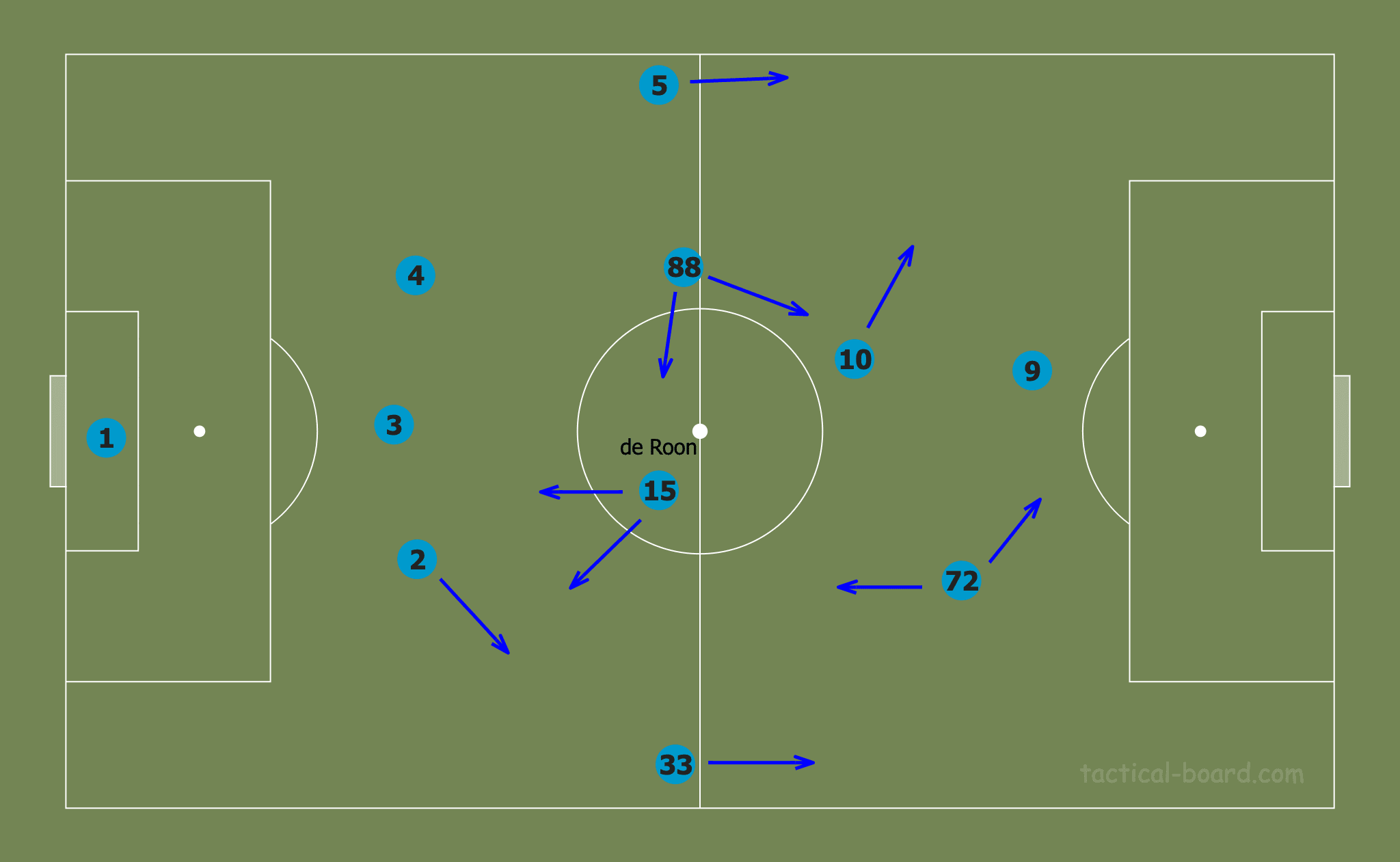
Atalanta are renowned for their attacking ability. With 57 goals already in the league – 10 more than Lazio with the second-highest – they are by far the most productive attack in Italy. They have scored five goals in two matches and seven in two more, with the latest coming away at Torino at the end of January in a 7-0 victory. They average 498.62 passes per match from 55.37% possession, highlighting Gasperini’s emphasis on establishing control against their opposition.
Defensively, Atalanta look to press often. They are consistently looking for opportunities to set up pressing traps in order to regain possession when the opposition is attempting to move forward. They boast a passes per defensive action (PPDA) stat of 8.32. This is the third-lowest in the league and shows that the side are quick to look for chances to win possession back.
While Atalanta begin in their three-back formation, this is constantly shifting as the match progresses. Just as the attacking trio are known for their fluidity when the side is in possession, the players that occupy the deeper spaces in the build-up are also interchanging situationally. Below you can see a pass map from Atalanta’s match against Inter Milan. This highlights de Roon’s (15) average position in Atalanta’s side. Here you are able to see the Dutch midfielder’s tendencies to drift into wider right areas. This is due to the structure that Gasperini sets up in his Atalanta side.
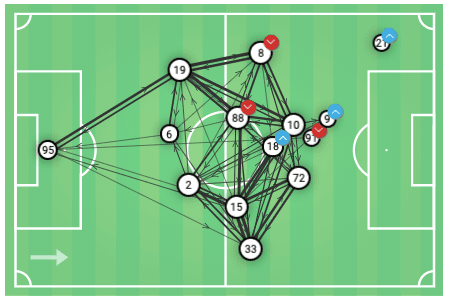
Attacking structure
One of de Roon’s primary roles in the side is to drop into deeper positions when Atalanta have possession and facilitate attacks from these areas. This will often include him taking up a position as a right-back, or even dropping into the space between the right and central centre-halves. In this area, de Roon is able to move away from opposition’s pressing structures in order to be able to find ways to exploit spaces left open. Players such as Gómez and Iličić are consistently moving in these areas to find space to receive passes and look for opportunities towards goal. Below you are able to see an example of this movement into the defensive line as a centre-half. Rafael Tolói (2) shifts to a right-back position, Hans Hateboer (33) moves forward, and Iličić drops into the midfield area to present a central option.
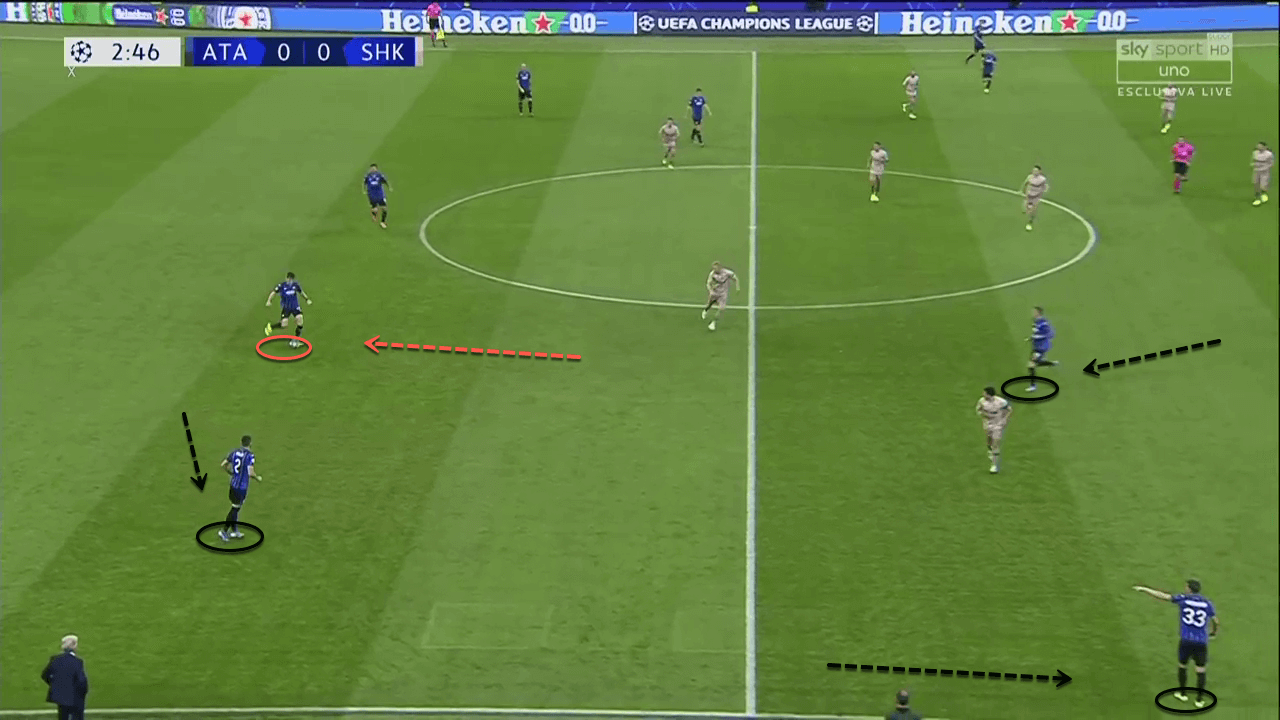
Typically, however, de Roon takes the position and role of an inverted full-back. Here, he has the ability to dictate play from deep positions and also has the opportunity to get forward when the opportunity arises. Below is an example of an area de Roon typically picks up possession. As you can see, he has plenty of room to operate as he has drifted into a deeper area as Iličić and Hateboer ahead of him stretch the Torini defensive structure.
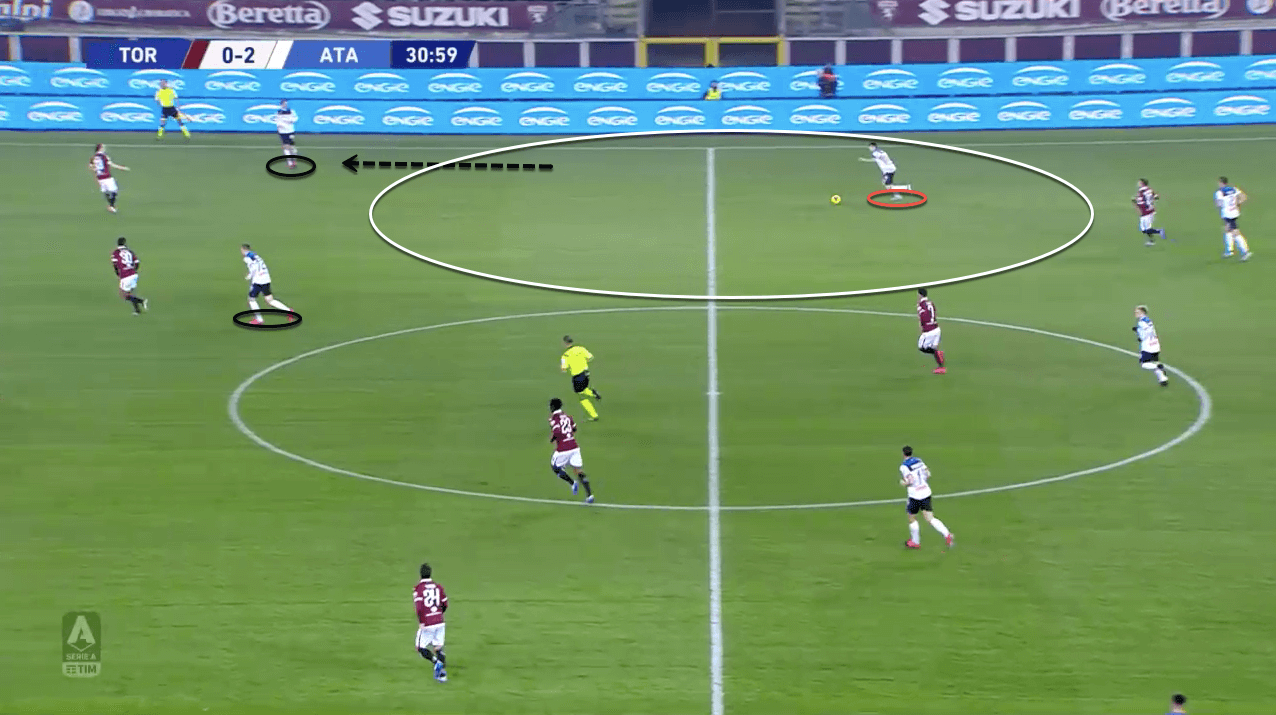
This also gives the wing-back on this right side the extra security and therefore ability to press higher up the pitch. A common attacking theme we see from Atalanta is Iličić dropping into deeper positions and holding up possession, allowing time for his wing-back to make an over or under-lapping run and finding them behind the opposition’s defensive line. Below, you can see another situation like the one above. Here, de Roon is occupying a very wide position. He allows Hateboer to move up in line with Iličić.
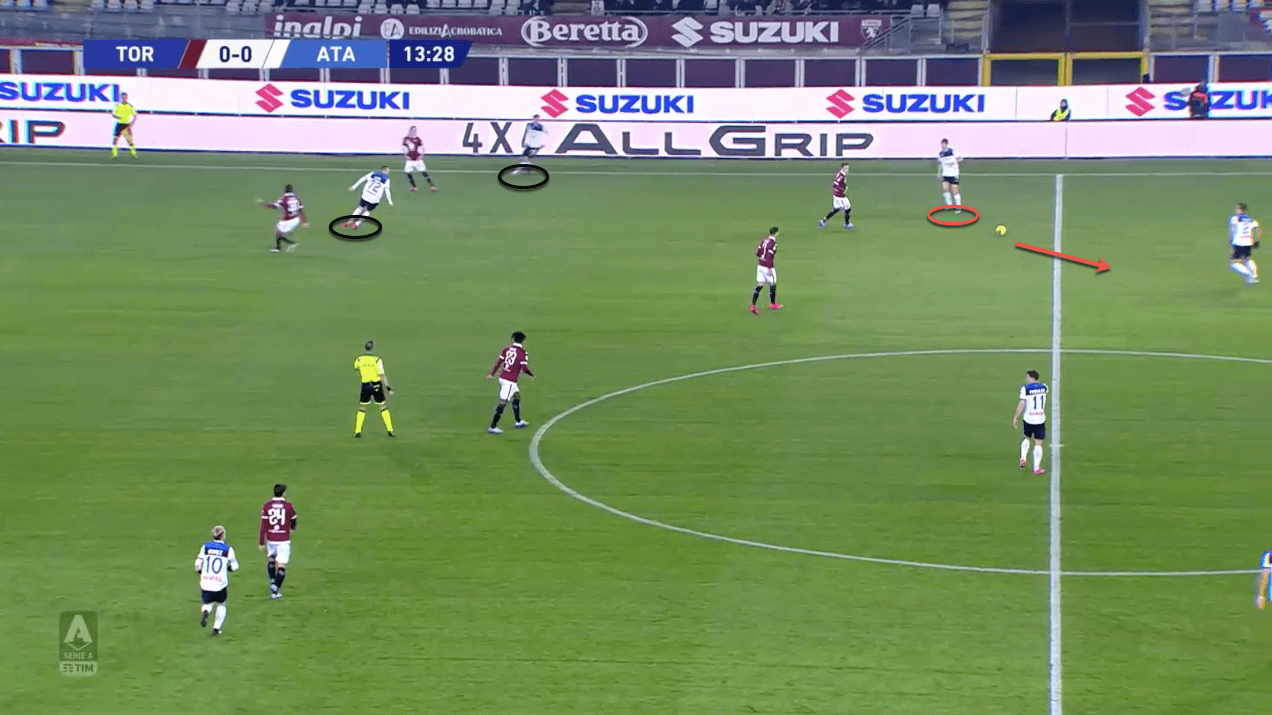
The Dutch international passes back into his central defender. The following move is a direct example of Atalanta’s fluidity. Iličić notices de Roon’s wide defensive position and moves to cover the gap left in the centre of midfield. As possession keeps moving Gómez drifts from his natural left side to aid in progressing it through Torino’s block. As Iličić drops in, Hateboer recognises the new space opening up higher up the pitch and moves into it, with the centre-half out of position having followed the Slovenian forward into midfield. Continuing this movement theme, de Roon presses forward into the wing-back position. Gómez finds the midfielder out wide here, who is quick to play a pass behind the Torino defence for Hateboer to run onto.
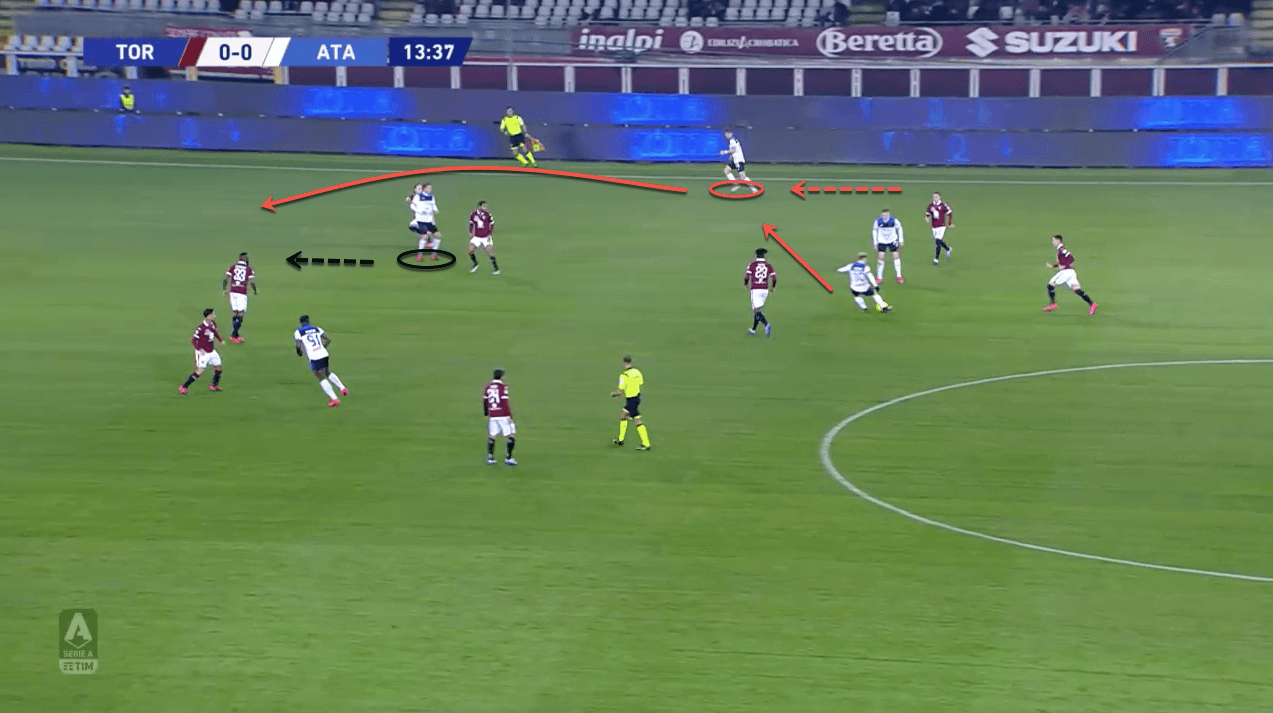
Defensive Positioning
Defensively, de Roon’s positioning and abilities aid in halting counter-attacks when they arise. The attacking set-up we looked at earlier takes into account these type of situations, and how to best get the side back into their attacking phase again once possession is lost as quickly and effectively as possible.
From an attacking perspective, de Roon’s typical positioning is done to allow the wing-back the freedom to move forward. This being said, when possession is lost in a circumstance such as this, it is the responsibility of de Roon to cover the area of the pitch behind his teammate. Atalanta have multiple looks in this situation depending on the current move. De Roon is equally comfortable slotting in between the right and central centre-halves, or out wide as a makeshift right-back.
In these positions, he is able to dictate play and also add extra protection to his side in the event of possession being lost. As you can see in the image from the match against Shakhtar in the previous section, the wing-backs are pushed very high up as they look to provide outlets for their teammates in possession. De Roon’s positioning allows Gasperini’s side to be better equipped to deal with a counter-attack that occurs when the wing-backs are caught high up the field.
Another view we see is de Roon holding a slightly higher but wider position. The positioning can be compared in part to an inverted full-back, such as the kind we see in Pep Guardiola’s Manchester City side. In this position, he is set up to protect the middle of the pitch in the event of an opposition counter-attack and is wide enough to cover the right touchline if the attack moves into that area.
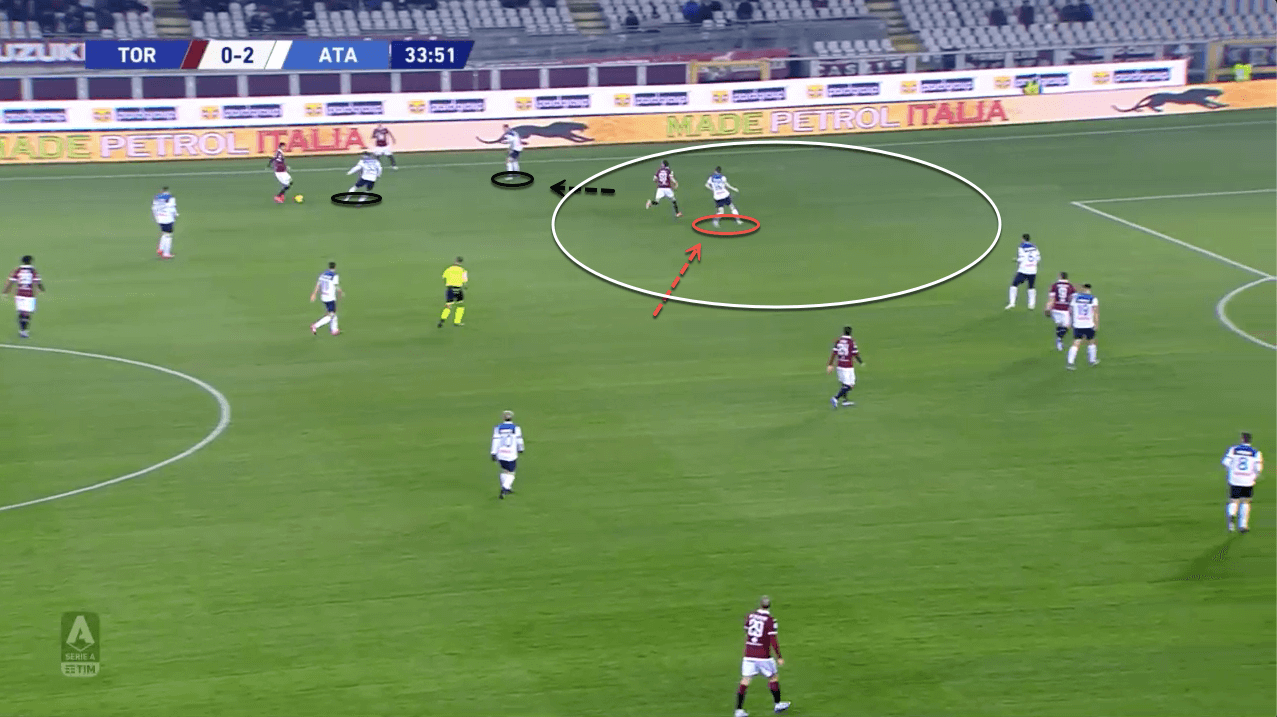
Above you can see an example of de Roon’s defensive awareness and anticipation. Hateboer and Toloi have pushed out wide as they track their markers in Atalanta’s defensive structure. A Torino midfielder realised the gap in the defence due to this and looks to move into the space in the channel. De Roon acknowledges the danger and tracks the runner into this centre-half position, and then is able to intercept the pass as Torino look to craft an attacking opportunity.
As we spoke on in the initial section, Atalanta boast a very low PPDA in the league. Gasperini looks for his side to press high up the pitch and look to win possession back off of attempted long passes by the opposition, before starting their attacking up from the back again. Below we can see an example of this pressing structure. Atalanta have pushed five players forward to restrict passing lanes for Inter Milan to build up in. Antonio Candreva is therefore forced into playing a ball over the top into Roberto Gagliardini in the centre of the pitch.
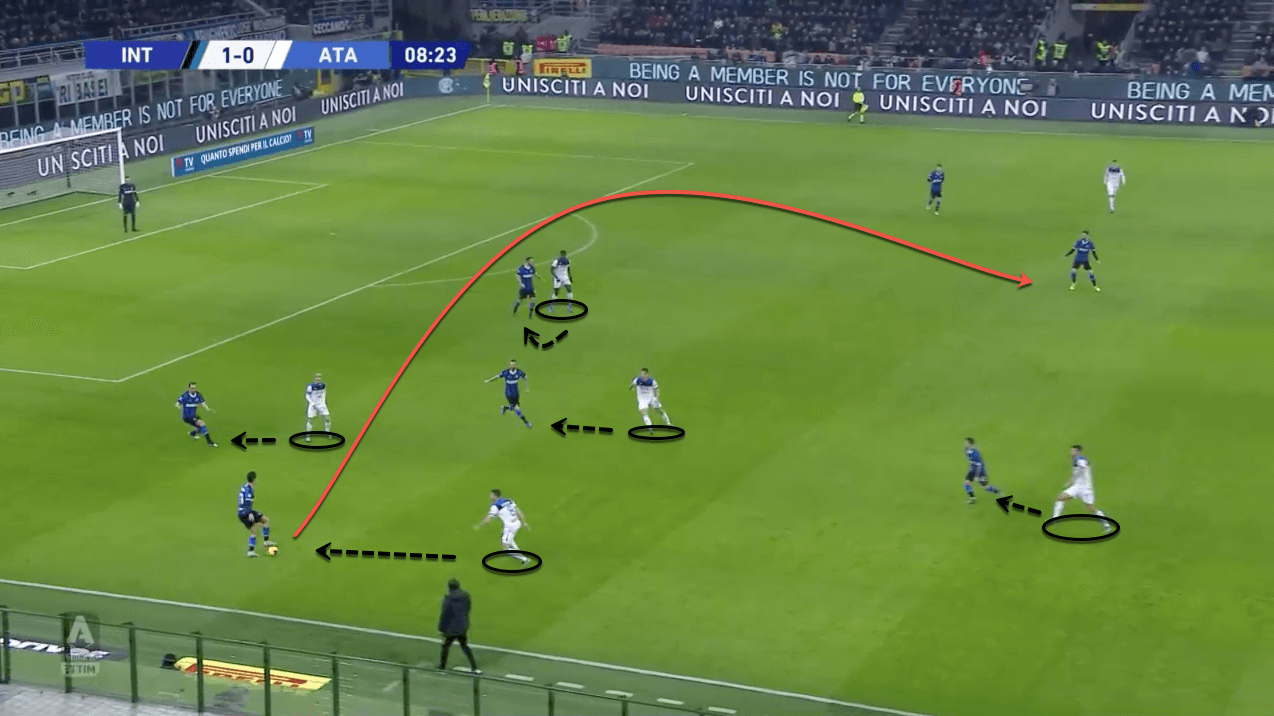
As this pass is made, it triggers the second phase of Atalanta’s press, which involves de Roon. He has been sitting in front of the defensive line in this move, waiting for the opportunity to challenge any pass made by Inter. As he sees this pass made, he jumps forward to press Gagliardini before the midfielder has a chance to control possession. The result of this press forces the Inter player to make a desperate forward pass in the air which is won back by Atalanta.
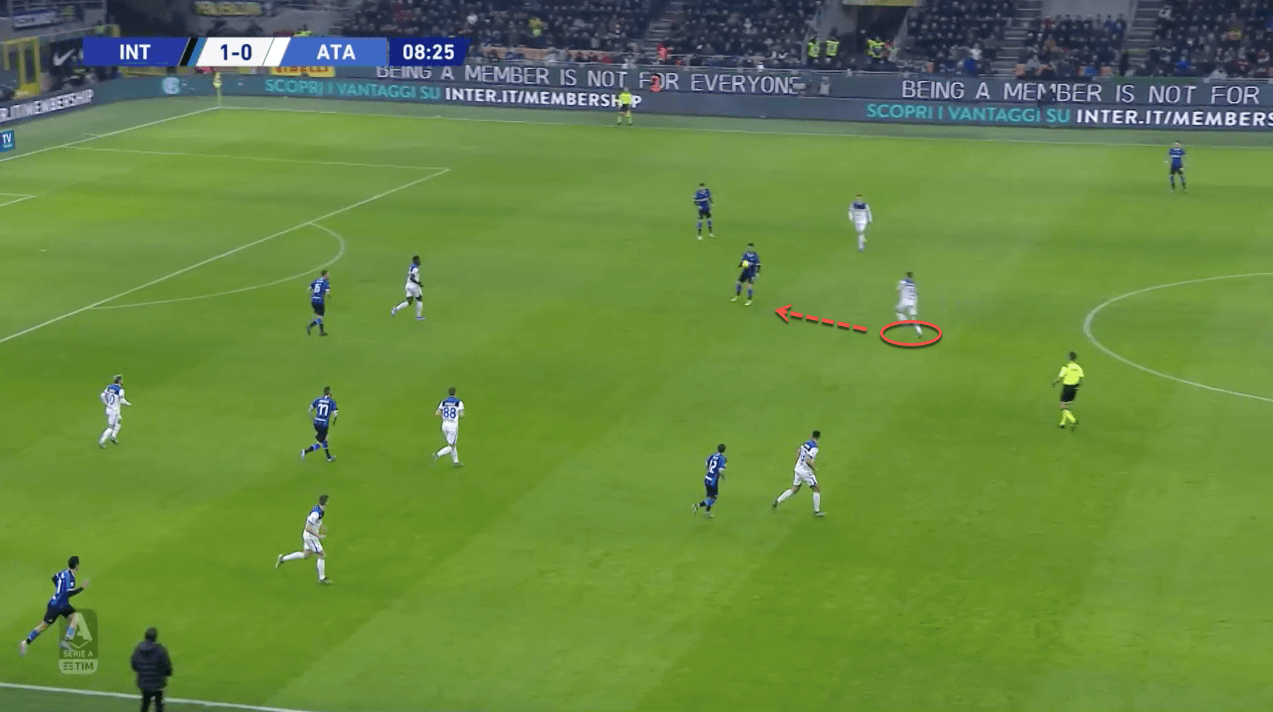
The Dutch set-up
The most interesting dynamic is how de Roon could fit into Ronald Koeman’s plans in the upcoming Euros. The Dutch midfielder has been integral for Atalanta and will definitely have caught the eye of his international coach as the summer approaches. There is very good reason as well as to why de Roon is making a case to be an integral part of their push back to prominence.
One of the main reasons behind the case for de Roon’s addition in the side is his ability to improve others around him. A key part of the Ajax side in the 2018/19 campaign was the role of Lasse Schöne. The Denmark international was often overlooked when it came to plaudits because he went about the small work to allow Ajax’s flair players to flourish. Below you can see a pass map of the Dutch side in their match last season against Feyenoord. Here you can see two trends with Schöne’s (20) positioning. It allows Frenkie de Jong (21) the freedom to do what he does best, in making penetrating runs from deeper positions. As well, as you can see with Matthijs de Ligt’s (4) position, the midfielder allows the centre-half to make forward runs by providing cover in this area.
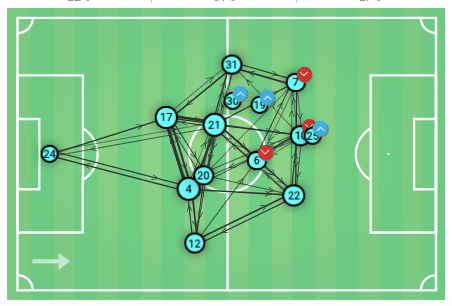
The positioning and responsibilities Schöne has in his role are similar to what de Roon has at Atalanta, and it is down to this that Gasperini’s metronome could be key in allowing stars like de Jong and de Ligt to shine. While de Jong likes to occupy a deep position, he is at his best when he is given the freedom to look for space to run into ahead of him. In these situations, the Barcelona man is an expert at drawing press into him to allow teammates to find pockets of space behind it. Schöne gave de Jong the ability to do this in his time at Ajax. We also can see this in Atalanta’s game at times. Typically, de Roon will be paired with Mario Pašalić or Remo Freuler in the heart of midfield, who both are more attacking-minded midfielders. De Roon’s defensive work allows them to look forward and try to combine with Atalanta’s attacking trio and wing-back on the left side.
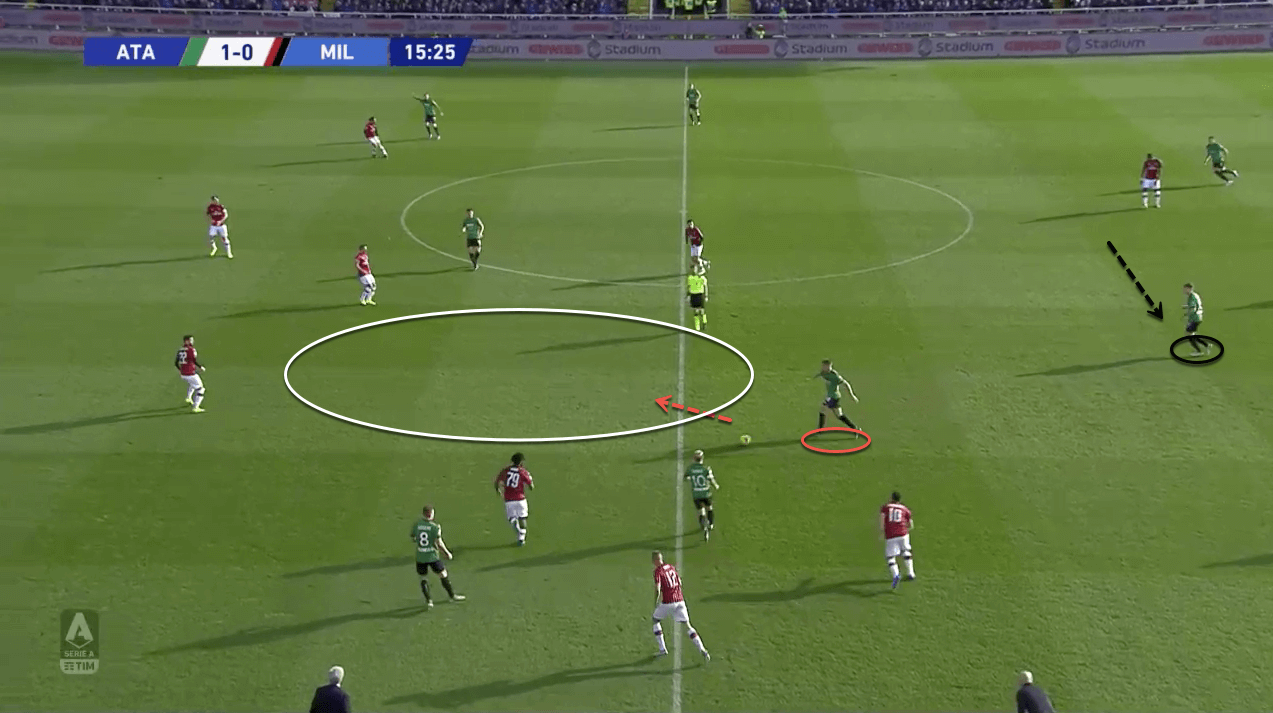
In the image above, we can see this situation in Atalanta’s match against AC Milan. At the bottom of the picture, the home side are pressing to win possession back. De Roon has moved into a more central position to add defensive cover as Atalanta load players into this area for the press. Gómez is able to win possession back and it comes into a central area. Pašalić is on hand to pick it up and dribble forward. He acknowledges the space he has to move forward and is supported by de Roon’s deeper positioning offering cover to allow him to progress the attack forward.
This is also the case with the Netherlands centre-halves. Both de Ligt and Virgil Van Dijk are exemplary with the ball at their feet. When oppositions set up in a deep block, they are able to use their passing and dribbling abilities to open up passing lanes and switch play from side to side with ease. With these two at centre-half, and de Roon paired alongside de Jong ahead of them, Koeman would have four players who offer the flexibility to work in almost any initial build-up structure. With both midfielders comfortable dropping into a central defender position, and both centre-halves capable of pushing into midfield.
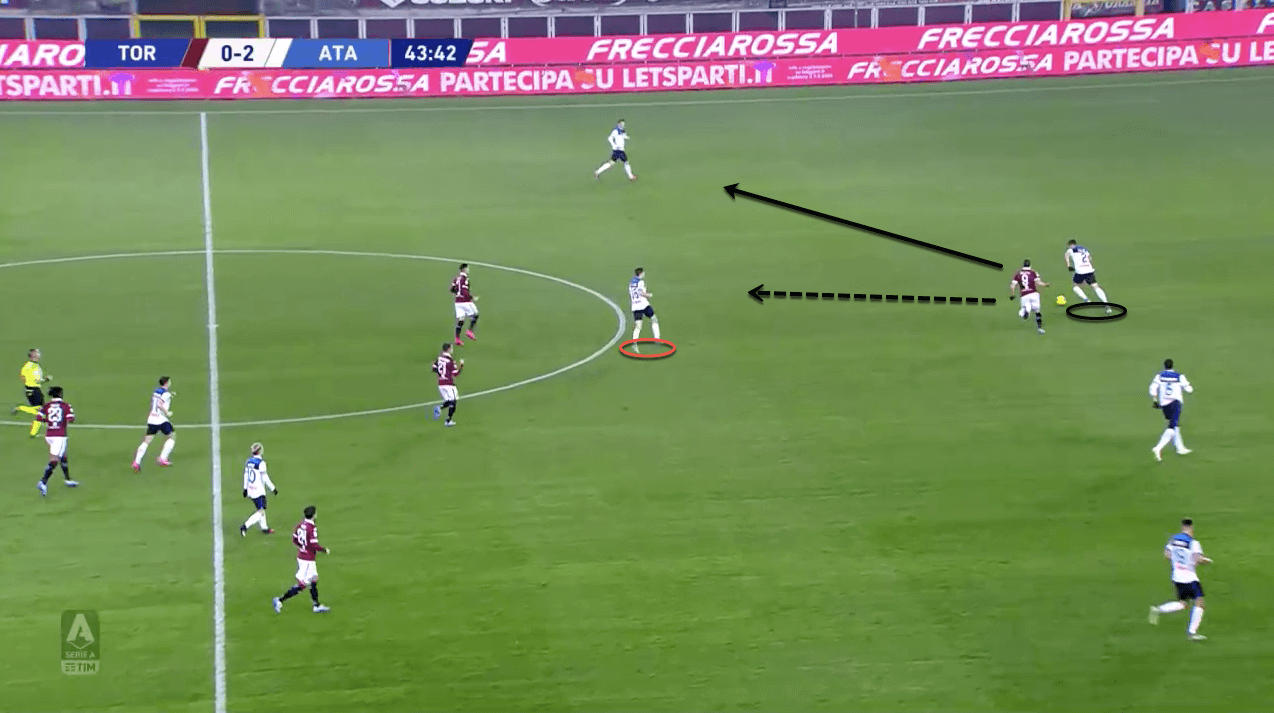
In the image above, you can see an example of Atalanta beginning their build-up following possession being regained. Quickly, Gasperini’s side look to switch the point of attack by moving to the right side of the pitch, with Tolói finding Hateboer out wide. The Brazilian centre-half then uses his momentum from his run and continues it up-field. He burst through the initial line of press, and de Roon drags his movement deeper to maintain space for the centre-half, and also provide cover. Hateboer finds Tolói with a pass back, who then makes a one-touch pass into Iličić out wide. The quickness of the attack by beating the initial press so easily did not give Torino time to set up their defensive structure, and the move resulted in Iličić drawing a penalty for the away side.
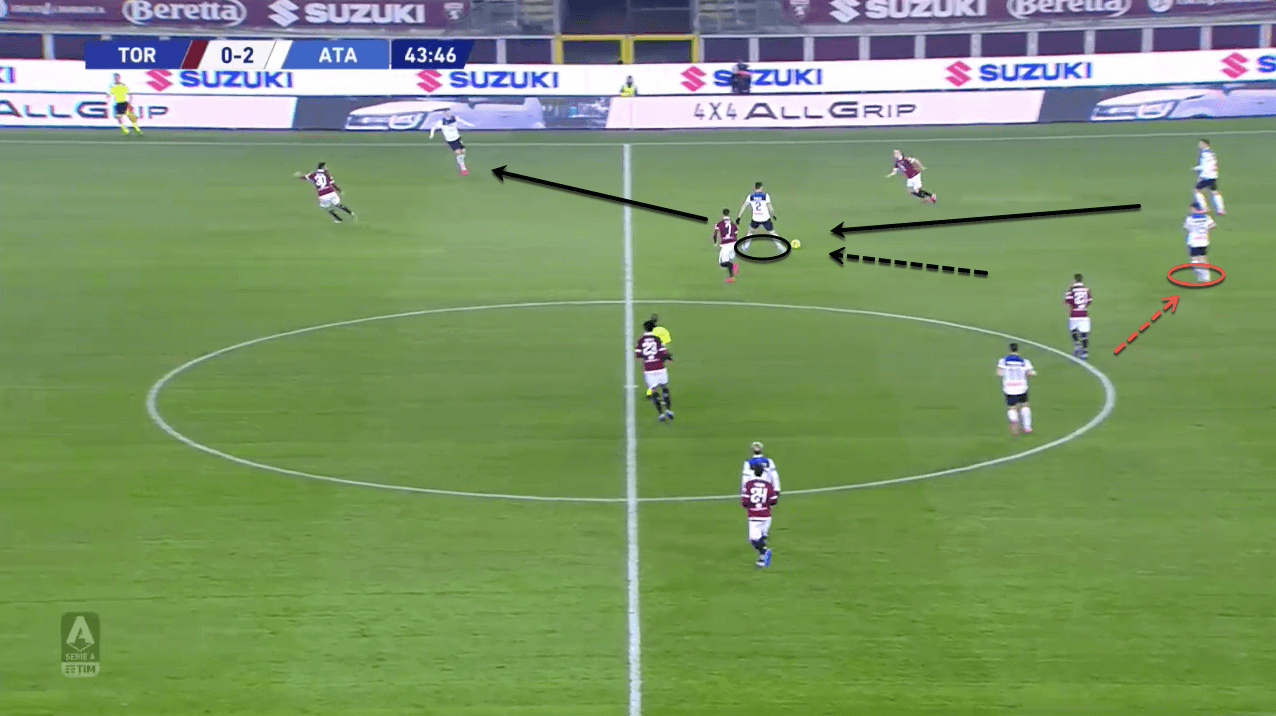
Conclusion
After an up and down beginning to the season, Atalanta are finally looking to settle into their stride and make a push forward yet again this year. They currently sit 5th place in the league, one point off 4th place Roma, and await a Champions League Round of 16 tie with Valencia this month.
One of the biggest keys to the Italian side is de Roon. We have seen just how essential the Dutch midfielder is to Gasperini’s side, and what he brings in all phases of the match. Going forward, he will continue to be crucial in any success Atalanta is able to achieve.
De Roon’s national team manager Koeman will also be taking a look with interest as Atalanta reach the business end of the campaign. With the Euros ahead, de Roon is making a major case to not only be selected but to be a major part of the side this summer. Only time will tell if this will be the case, but as we have seen above, his style and adaptability could be essential in allowing the Dutch’s flair players to be at their best.

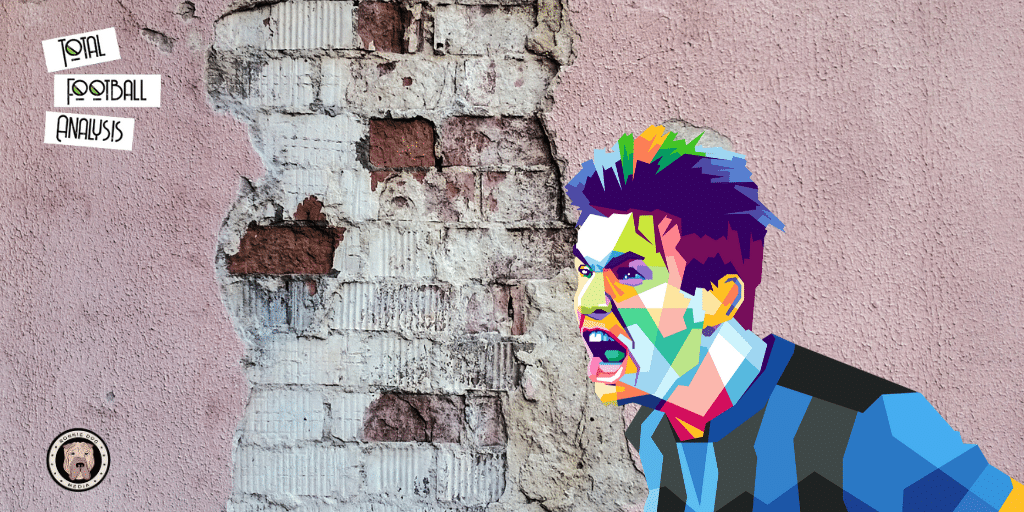




Comments